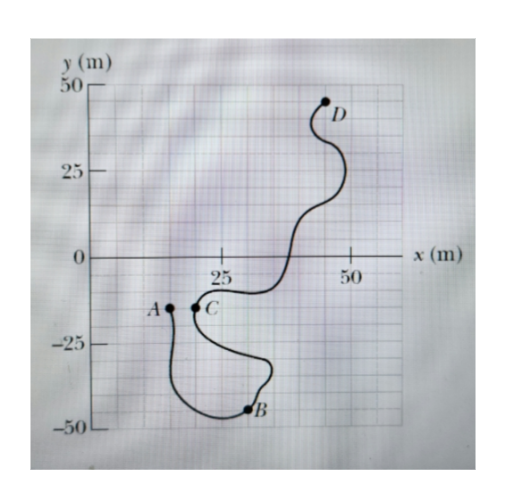The figure gives the path of a squirrel moving about on level ground, from point A (at time t = 0), to points B (at t = 5 min), C (at t = 10 min), and finally D (at t = 15 min). Consider the average velocities of the squirrel from point A to each of the other three points. Of them, what are the (a) magnitude and (b) angle of the one with the least magnitude and (c) the magnitude and (d) angle of the one with the greatest magnitude? Give the angles in the range (-180°, 180°] y (m) 50 25 0 -25 -50 A 25 C B 50 x (m)
![The figure gives the path of a squirrel moving about on level ground, from point A (at time t = 0), to points B (at t = 5 min), C (at t
= 10 min), and finally D (at t = 15 min). Consider the average velocities of the squirrel from point A to each of the other three points. Of
them, what are the (a) magnitude and (b) angle of the one with the least magnitude and (c) the magnitude and (d) angle of the one with
the greatest magnitude? Give the angles in the range (-180°, 180°]
y (m)
50
25
0
-25
-50
25
C
B
D
50
x (m)](/v2/_next/image?url=https%3A%2F%2Fcontent.bartleby.com%2Fqna-images%2Fquestion%2Fddb995b2-9310-4681-9b7d-bca93438dbc6%2Fb0fe876d-567e-4d16-8481-781c4b8ed6ee%2F2qk49hf_processed.jpeg&w=3840&q=75)
To calculate the magnitude and direction of the lowest average velocity and the magnitude and direction of the highest average velocity.
Given:
The path of the squirrel:
The time taken to get to B:
The time taken to get to C:
The time taken to get to D:
To calculate:
(a) The magnitude of the least average velocity:
(b) The angle of the least velocity:
(c) The magnitude of the highest average velocity:
(d) The angle of the highest velocity:
The average velocity of a body is defined as the ratio of the displacement of the body to the time taken for the displacement.
The displacement of a body is defined as the shortest distance between the initial and the final position of the body. If the body moves in a cartesian coordinate system, then the displacement of the body is defines as:
where,
are the x and y-coordinates of the initial position and
are the x and y-coordinates of the final position.
Trending now
This is a popular solution!
Step by step
Solved in 8 steps with 1 images









